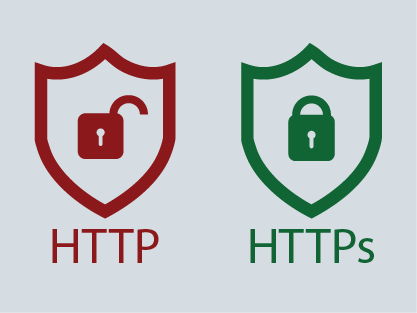Check out our White Paper Series!
A complete library of helpful advice and survival guides for every aspect of system monitoring and control.
1-800-693-0351
Have a specific question? Ask our team of expert engineers and get a specific answer!
Sign up for the next DPS Factory Training!

Whether you're new to our equipment or you've used it for years, DPS factory training is the best way to get more from your monitoring.
Reserve Your Seat TodayWhen you type a URL into your browser, you're stepping into a world driven by ports, protocols, and packets. Most of us simply type "www.something.com" and expect the website to load. However, there are two crucial ports behind any web request: Port 80 (HTTP) and Port 443 (HTTPS).
For casual web browsing, these may sound like obscure details. Your only interaction with it might be looking for a "Secure" or "Not Secure" message when logging into your bank or other sensitive website.
But if you manage industrial network infrastructure, telecom sites, or utility networks, the choice between Port 80 and Port 443 is a major security concern.
Let's review how these ports work, why one is inherently more secure than the other, and how you can use this knowledge to benefit your remote monitoring.

Port 80 supports HTTP (HyperText Transfer Protocol), which defined the earliest days of the World Wide Web. In those early days, the internet was a smaller community, and concerns about eavesdropping were limited. Most people, including criminals, just weren't online yet.
As a result, HTTP connections are unencrypted, which makes them easy targets for interception or tampering.
An HTTP session is like sending a postcard. Anyone who touches a postcard can read its contents. This can be dangerous if you're handling sensitive data or monitoring critical infrastructure.
Port 443 is reserved for HTTPS: HTTP secured by SSL/TLS encryption. This extra layer scrambles data in transit. Only the sender and the intended receiver have the keys to decipher it.
An HTTPS connection is like sending a locked briefcase. If someone intercepts it, they can't see what's inside without the key (or with enough "brute force" to bypass the key, but modern encryption is a very strong briefcase).
Managing telecom huts, power substations, rail control points, or utility networks often involves remote access via web interface. You might need to:
Whether you're monitoring environmentals or performing necessary upgrades, you're sending commands and passwords over a network. If that connection isn't encrypted, an attacker can capture your credentials, alter your commands, or suppress critical alarms.
Using HTTP (Port 80) in an industrial or utility setting can have severe repercussions:
Free, widely available network-sniffing tools can easily intercept your unencrypted traffic. Plan for encrypted data transfer to make sure you don't compromise your system's security.
Given these risks, why does Port 80 persist? Often times, older devices will default to HTTP:
Although it might have been acceptable in less security-conscious times, it's now a major liability to use Port 80. Modern browsers even display alerts for HTTP pages, warning users of potential dangers.
In older systems, encryption could introduce noticeable lag. However, nowadays, that penalty is minimal. TLS 1.3 has streamlined the handshake process, and modern CPUs - often even the embedded ones in RTUs - handle encryption efficiently.
For example, NetGuardian RTUs and T/Mon master stations are optimized for HTTPS. You'll see minimal, if any, slowdown. Given the security benefits, the trade-off is undoubtably worth it.
Securing mission-critical networks means moving all remote access to Port 443. Ideally, each device in your infrastructure should support HTTPS for:
Modern cybersecurity isn't a luxury. It's an operational necessity to prevent real-world breaches and maintain user confidence.
For over 30 years, DPS Telecom has been developing remote monitoring and control solutions for high-stakes industries. We integrate HTTPS at the core of our devices:
Not all older hardware can run HTTPS, especially if manufacturers never added it. Luckily, you can still secure your network without discarding everything by using:
You don't always need a complete forklift upgrade. Be sure to ask DPS about the simplest path to encryption for your existing infrastructure.
It's tempting to think, "My monitoring network is isolated, so HTTP is fine." But internal networks can quickly become exposed for several reasons:
The best practice is to design with HTTPS from day one. This avoids the hassle of having to retrofit security later.
Industries across the board - telecom, utilities, rail, healthcare, finance - operate under data security mandates. These mandates include:
Most of these mandate or strongly recommend encryption in transit. By using HTTPS (Port 443), you can keep data secure, demonstrate proactive risk management, and avoid penalties or forced downtime.
The switch from HTTP to HTTPS might sound daunting because it has multiple parts - certificates, encryption settings, and firewall rules. However, it's simpler than you might imagine:
The net benefit - having a secure, compliant, future-proof network - far outweighs the modest effort to configure encryption.
HTTP (Port 80) is insecure. HTTPS (Port 443) is the norm for most environments that require data integrity and security.
Don't wait for a breach or audit failure to force your hand. Proactive encryption is a fundamental layer of defense for remote monitoring.
Call me at 559-454-1600 or email sales@dpstele.com to discuss how you can upgrade your remote monitoring devices to support HTTPS.

Andrew Erickson
Andrew Erickson is an Application Engineer at DPS Telecom, a manufacturer of semi-custom remote alarm monitoring systems based in Fresno, California. Andrew brings more than 18 years of experience building site monitoring solutions, developing intuitive user interfaces and documentation, and opt...